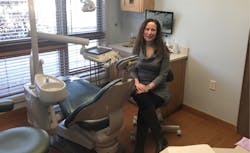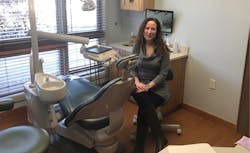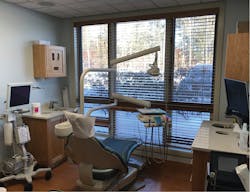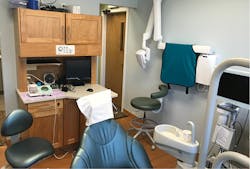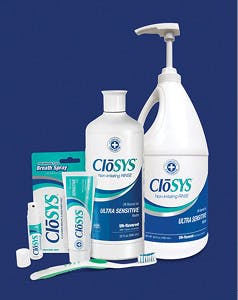Proud of my op: Nicole Fortune, MBA, RDH
A relaxing, spa-like experience while having periodontal treatment may sound like an oxymoron, but Nicole Fortune, MBA, RDH, has created one in her operatory at Chamberlain Periodontal in South Burlington, Vermont. “My room is a soothing light blue. The dental chair is heated and massaging,” she writes. “My room is at the end of the hall, so it is quiet. With the TV on the ceiling and on the chair, I turn off the lights and patients have a relaxing experience.” But the spa-like experience belies the serious periodontal therapy happening in her op. Using a combination of periodontal endoscopy, an Nd:YAG laser, and aqueous powder streaming, Nicole is seeing positive, healing results for her patients.
Nicole explains, however, that it wasn’t always like this. She says about four years ago, her boss asked if she would be interested in using a periodontal endoscope. She said yes, even though she couldn’t recall any recent information about its use. She began researching the effectiveness of an endoscope for perio treatment and came away with a positive impression. “The results with an endoscope can be phenomenal, similar to surgical results. There was little to no promotion of its use in the literature and online communities, as it seemed only very specialized groups were utilizing the endoscope and few ‘everyday’ hygienists and doctors had embraced it.” Once the equipment was purchased and put into use, it didn’t take long for Nicole to become a fan. “Why weren’t people shouting from the rooftops how important this equipment is for our patients and our profession?” she exclaims. “After I saw the results from my first cases, I made it my mission to spread the word about this amazing technology.”
Nicole Fortune, MBA, RDH, in her operatory
As with most new technologies, it’s not always easy to operate right off the bat. “The learning curve of the endoscope is steep, and it took a good 10 or more cases to be confident and proficient. This meant scheduling additional time was necessary in the beginning, with a single full quadrant taking about two hours to complete. Now I rarely need to add time to the appointment. Also, the endoscope allows me to sit upright rather than look down at my patient.” Nicole raves about the better visualization of subgingival areas via the very thin, flexible fiber-optic probe with a camera and light. The sulcus is lit and magnified, allowing improved visibility of calculus deposits for removal. “We began using the endoscope on natural dentition, but now I use it in the treatment of peri-implantitis. I am able to see the etiology clearly, such as cement, bacteria-laden microgaps, or overhanging restorations. The etiology can be removed with minimal damage to the implant surface and patient care is customized to the specific variables of each case.” Nicole said the endoscope is offered as an option to patients during scaling and root planing since the added expense is not covered by dental insurance.
Nicole also uses an Nd:YAG laser in her op. It is used to kill bacteria in the pocket with short bursts of a specific wavelength to target and destroy Porphyromonas gingivalis, the main culprit of periodontal disease. Nicole says, “I use an Nd:YAG laser for bacterial reduction on almost all of my patients. Even if the patient is periodontally healthy or stable, the laser is another way to manage the destructive pathogens.”
Patients have a view of a wooded area in the chair.
Laser use sparks debate in the dental world, as studies have landed on both the positive and negative sides of its efficacy. Nicole suggests hygienists read thoroughly the details of clinical studies to see if laser use would be beneficial for the particular patient. “I know my stance on lasers is met with criticism from some of my peers, but the benefits are more than clinical. My schedule is usually full with SRP patients and the laser is used on each of those patients. I started using the laser during recall visits with patients who are periodontically fragile (heavy bleeding, uncontrolled diabetes, failing implants, etc.), and I found over time these patients would stabilize. I am not claiming that laser use during a maintenance visit is the reason for their periodontal health, but it was a large piece of that. Research has shown that the level of gram-negative bacteria is reduced after laser use and it remains that way for over 50 days. This gives the patient’s immune response an advantage and helps the body do what it wants to do . . . heal.”
Nicole has also found the laser restores confidence in patients who feel their disease is hopeless, because they finally see a change in their periodontal health. “Once I started using lasers during maintenance visits, I noticed a change in the patient psychology. Lasers are a new technology for them, and they respect and appreciate the effort to use this technology in their case.” She says this often causes a renewed patient interest and better compliance when sticking to a periodontal protocol cycle.
The operatory décor incorporates soothing colors and natural materials.
Using the periodontal endoscope and the laser together targets all three areas: it kills pathogens in the sulcus, removes calculus deposits due to magnification and better visualization, and closes the pockets with heat coagulation. Also known as LANAP (laser-assisted new attachment procedure), once calculus is removed with help from the endoscope, the warmth of the laser seals the pocket with stem cells to make a sticky, yellowish seal to prevent bacteria from entering the now-clean pocket areas. “There have been many cases where bone has regenerated after endoscopy with laser bacterial reduction, even with implants. It’s a game changer,” she says.
Nicole recommends CloSys products to patients to use postoperatively and as part of home care, as well as TePe interdental brushes. “CloSys seems to be well tolerated by all of our patients,” she says. “The benefit of this product goes beyond bad breath.” The various size choices of TePe brushes are helpful to clean around posterior implants. “Patients appreciate the custom fit, and I notice a difference with their ability to manage food debris and plaque.” She says, “Loupes are a must for me, and I love my Surgitel loupes with the light attachment.”
Nicole recommends CloSys products as a regular part of home care.
“As hygienists, we have so many things on our minds at all times, it’s easy to be overwhelmed and stressed,” Nicole says. “Having a calming environment definitely helps me stay focused and centered on the patient. My doctor comments to the patients on how nice the room is. ‘You’re in the suite today’ is a typical comment. It’s nice to hear that he appreciates how I try to maintain a calming and accepting environment for patients.”
Thanks, Nicole, for sharing your relaxing operatory and technical experience with endoscopy and lasers with us.